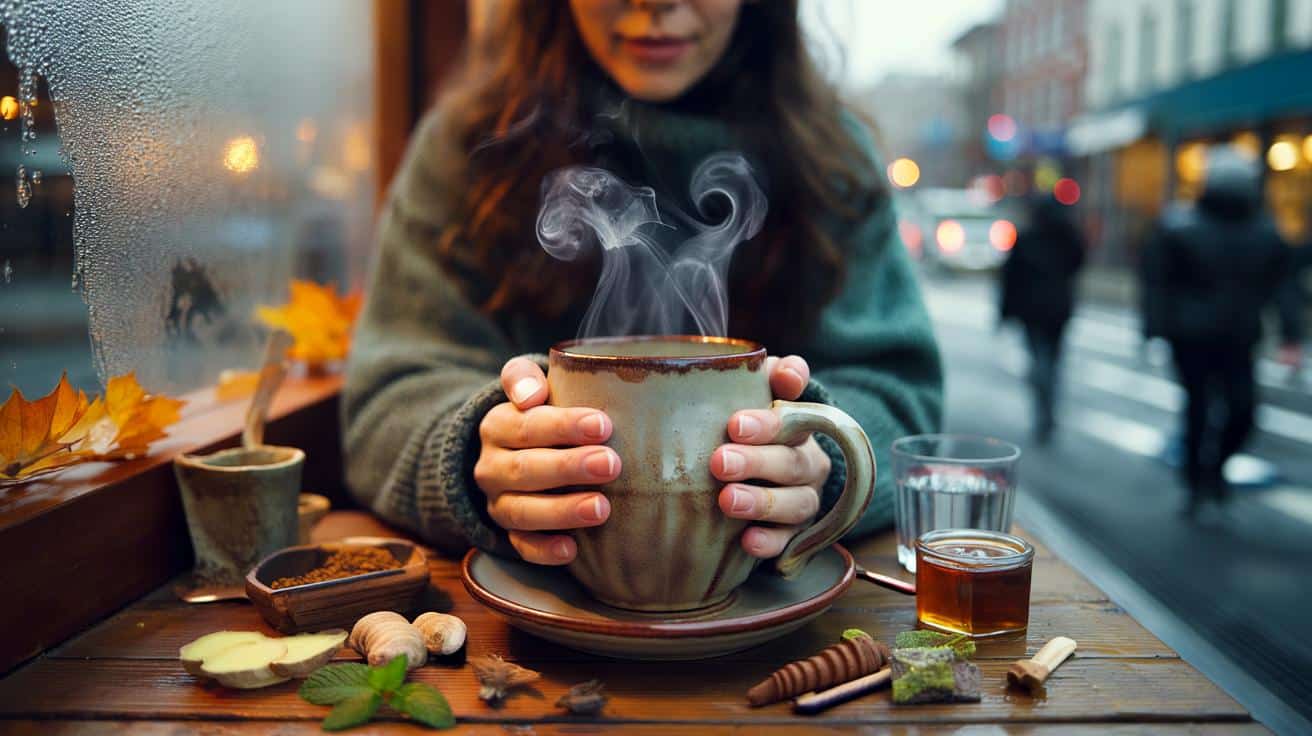The first chill arrives quietly. Mornings bite, afternoons dim early, and your hands keep drifting towards a warm mug as if guided by muscle memory. You weren’t thinking about tea last month. Now you crave it before your coat is even zipped.
Buses hiss. Breath turns visible. Somewhere between the first sip and the slow exhale, shoulders drop a notch you didn’t know they were holding. You’re not just drinking something. You’re changing the weather inside your body. Who started this ritual—your mind or your metabolism? A short answer rises with the steam. Your body asked first.
October switches on your inner thermostat
When the air cools, your body gets busy with heat management. Blood vessels in your skin tighten to conserve warmth, the brain nudges you towards behaviours that generate comfort, and your mouth becomes a quick doorway for heat to enter. A hot drink doesn’t just touch your tongue; it lights up temperature sensors, cues a gentle rise in core warmth, and offers the brain a reliable “we’re safe” signal. The craving you feel is not a whim. It’s thermoregulation, politely knocking.
Walk down a high street in mid-October and you’ll see it: steamed-up café windows and hands cocooned around takeaway cups. Retailers report seasonal spikes in tea, coffee and cocoa sales as daylight shortens. Search data tends to surge for “hot chocolate” and “ginger tea” just as radiators begin their annual debate. **We label it cosy, but your body reads it as practical.** People don’t queue for a latte because it looks nice on a table. They queue because warmth is currency in colder air.
There’s a sensory trick at play too. Heat activates receptors in your mouth that are wired to the brain’s thermostat, so a hot sip can make you feel warmer than the thermometer says. Aromas ride the same neural highways as memory and emotion, adding a bonus layer of comfort. Meanwhile, cooler months push your metabolism to spend more energy on heat, nudging appetite and taste towards richer flavours. A mug does a lot of small things at once—none dramatic, all convincing—until craving feels inevitable.
Build a better brew for colder days
Start your mornings with a temperature you can hold without flinching. 60–65°C is warm enough to satisfy, gentle enough for your mouth. Stir in a little ginger or cinnamon to trigger a warmer sensation without extra sugar, and breathe out through your nose as you sip to amplify aroma. If you wake groggy, black tea or a light coffee gives lift; later in the day, swap to rooibos or barley tea. Hold the mug with both hands. Let the heat meet your pulse.
Small tweaks matter. Avoid scalding liquids that irritate the throat and numb taste. Add a splash of milk or oat drink to smooth bitterness and slow the caffeine kick if you run anxious. Go easy on syrupy shortcuts; sweetness warms fast and crashes faster. Keep a glass of water nearby because cool weather blunts thirst while radiators dry air. Soyons honnêtes : personne ne fait vraiment ça tous les jours. The goal isn’t perfection. It’s a kinder habit you’ll actually keep.
Think of your brew as a pacing tool for the day. Caffeine in the morning nudges alertness; a spiced herbal at dusk says, “we’re landing the plane.” Let the ritual set a rhythm, not a rush.
“A hot drink is a boundary you can hold—one you can feel, smell, and finish.”
- Swap late coffee for chai rooibos to keep the flavour, ditch the jitters.
- Add a thumb of fresh ginger for warmth that lingers without extra sugar.
- Use a wide, heavy mug; more contact, slower cooling, longer comfort.
Memory, mood and the quiet power of steam
We’ve all lived that moment when a familiar brew takes you home in one breath. The smell of black tea might conjure your gran’s kitchen; a milky coffee might whisper of a shared table in a student flat. Scent and temperature travel fast to the brain’s emotional centres, stitching warmth to stories you already love. That memory-heat combo is quick medicine for a grey afternoon. It’s not nostalgia for nostalgia’s sake. It’s your brain borrowing old safety to solve a new chill.
Take Maya in Manchester, who keeps a jar of cardamom on the counter from October to March. She cracks a pod into her morning tea, and the kitchen shifts mood instantly—peppery, floral, bright. Two sips in, she stops scrolling, stands taller, and faces the day with less edge. Later, she switches to mint and honey, a soft landing after the commute. None of this is grand wellness theatre. It’s tiny, repeatable cues that stabilise the season.
Your gut joins the conversation too. Warm liquids can soothe the stomach’s pace, easing that tense, cold-day clench many of us ignore, while steady sips nudge the nervous system towards rest. Your body is listening when you lift the mug. Shorter days also tug at mood through shifting light and routine; the predictability of a brew restores a bit of control and kindly dopamine. Call it practical comfort. It’s chemistry with manners.
Sip, notice, repeat
October invites a new tempo: slower mornings, earlier nights, and more moments that hinge on what’s in your hands. A hot drink sits right at that hinge, doing quiet work on temperature, tension and time. Choose blends that match the hour, pour at a kind heat, and let the ritual carry a little meaning—five minutes you don’t negotiate, even on a messy day. **A mug can be both tool and companion.** Share the recipe that saves your mood, borrow one from a friend, and keep a jar of something fragrant near the kettle. The season will keep turning. So will the steam.
| Point clé | Détail | Intérêt pour le lecteur |
|---|---|---|
| Thermostat interne | Warm drinks cue heat sensors and calm the stress response | Understand why cravings spike and how to satisfy them smartly |
| Timing et choix | Caffeine early, spices later, gentle temperatures always | Better energy without jitters or restless nights |
| Rituel utile | Repeatable steps turn a sip into a mood anchor | Simple routine that steadies grey days |
FAQ :
- Does a hot drink actually warm my core?A modest amount, yes. Heat in your mouth and throat nudges warmth and signals comfort to the brain, which feels bigger than the thermometer change.
- Tea or coffee—what’s better in October?Pick by purpose: tea for steady lift, coffee for a sharper start, herbal blends for evenings. The best choice is the one that fits the hour.
- What temperature should I drink at?Warm enough to enjoy without wincing—roughly 60–65°C works for most. Scalding drinks dull flavour and irritate the mouth.
- Do hot drinks dehydrate me?Not in a meaningful way when taken in normal amounts. Keep water nearby because cooler air hides thirst, especially indoors.
- Are spices like ginger actually helpful?They add a pleasant warming sensation and lively flavour, which can reduce the pull of extra sugar. Fresh or ground both work.








